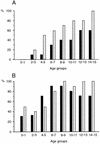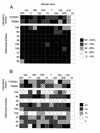Age-related buildup of humoral immunity against epitopes for rosette formation and agglutination in African areas of malaria endemicity
- PMID: 9746579
- PMCID: PMC108590
- DOI: 10.1128/IAI.66.10.4783-4787.1998
Age-related buildup of humoral immunity against epitopes for rosette formation and agglutination in African areas of malaria endemicity
Abstract
In this report, we show an age-related buildup of agglutinating activity as well as serum activity against rosette formation in children living in areas of Kenya and Gabon where malaria is endemic. Sera from Kenyans in general exhibited a stronger and wider immune response toward the epitopes, probably reflecting a difference in transmission patterns between the two areas. Thus, our results indicate that repeated malaria attacks in areas of endemicity, and consequently exposure to different isolate-specific antigens, will elicit an antibody-mediated response eventually enabling recognition of the majority of rosetting and agglutinating antigens. The correlation between antirosetting and agglutinating capacity was poor in individual cases, indicating that the rosetting epitopes are only a minor part of the highly diverse surface-exposed antigens (mainly PfEMP1) on the surface of parasitized erythrocytes toward which antibodies may react. These data together with our previous findings that the protection against cerebral malaria correlates with presence of antirosetting antibodies shed new light on our understanding of the gradual acquisition of immunity toward severe complications of malarial infection which children reared in areas of endemicity attain.
Figures




 ). Sera
from 10 to 14 individuals in each age group were tested.
). Sera
from 10 to 14 individuals in each age group were tested.Similar articles
-
Erythrocyte rosetting in Plasmodium falciparum malaria--with special reference to the pathogenesis of cerebral malaria.Scand J Infect Dis Suppl. 1993;86:1-79. Scand J Infect Dis Suppl. 1993. PMID: 8493454
-
Disruption of erythrocyte rosettes and agglutination of erythrocytes infected with Plasmodium falciparum by the sera of Papua New Guineans.Trans R Soc Trop Med Hyg. 1996 Jan-Feb;90(1):80-4. doi: 10.1016/s0035-9203(96)90487-3. Trans R Soc Trop Med Hyg. 1996. PMID: 8730319
-
The humoral response to Plasmodium falciparum VarO rosetting variant and its association with protection against malaria in Beninese children.Malar J. 2010 Oct 5;9:267. doi: 10.1186/1475-2875-9-267. Malar J. 2010. PMID: 20923548 Free PMC article.
-
Pregnancy-specific malarial immunity and risk of malaria in pregnancy and adverse birth outcomes: a systematic review.BMC Med. 2020 Jan 16;18(1):14. doi: 10.1186/s12916-019-1467-6. BMC Med. 2020. PMID: 31941488 Free PMC article.
-
Three Is a Crowd - New Insights into Rosetting in Plasmodium falciparum.Trends Parasitol. 2017 Apr;33(4):309-320. doi: 10.1016/j.pt.2016.12.012. Epub 2017 Jan 18. Trends Parasitol. 2017. PMID: 28109696 Review.
Cited by
-
DNA immunization with the cysteine-rich interdomain region 1 of the Plasmodium falciparum variant antigen elicits limited cross-reactive antibody responses.Infect Immun. 2003 Aug;71(8):4536-43. doi: 10.1128/IAI.71.8.4536-4543.2003. Infect Immun. 2003. PMID: 12874333 Free PMC article.
-
Detection of naturally acquired, strain-transcending antibodies against rosetting Plasmodium falciparum strains in humans.Infect Immun. 2024 Jul 11;92(7):e0001524. doi: 10.1128/iai.00015-24. Epub 2024 Jun 6. Infect Immun. 2024. PMID: 38842304 Free PMC article.
-
SURFIN4.1, a schizont-merozoite associated protein in the SURFIN family of Plasmodium falciparum.Malar J. 2008 Jul 1;7:116. doi: 10.1186/1475-2875-7-116. Malar J. 2008. PMID: 18593471 Free PMC article.
-
Blood group A antigen is a coreceptor in Plasmodium falciparum rosetting.Infect Immun. 2000 May;68(5):2971-5. doi: 10.1128/IAI.68.5.2971-2975.2000. Infect Immun. 2000. PMID: 10768996 Free PMC article.
-
Small, clonally variant antigens expressed on the surface of the Plasmodium falciparum-infected erythrocyte are encoded by the rif gene family and are the target of human immune responses.J Exp Med. 1999 Nov 15;190(10):1393-404. doi: 10.1084/jem.190.10.1393. J Exp Med. 1999. PMID: 10562315 Free PMC article.
References
-
- Aguiar J C, Albrecht G R, Cegielski P, Greenwood B M, Jensen K B, Lallinger G, Martinez A, McGregor I A, Minjas J N, Neequaye J, Patarroyo M E, Sherwood J A, Howard R J. Agglutination of Plasmodium falciparum-infected erythrocytes from East and West African isolates by human sera from distinct geographic regions. Am J Trop Med Hyg. 1992;47:621–632. - PubMed
-
- Baruch D I, Pasloske B L, Singh H B, Bi X, Ma X C, Feldman M, Taraschi T F, Howard R J. Cloning the P. falciparumgene encoding PfEMP1, a malarial variant antigen and adherence receptor on the surface of parasitized human erythrocytes. Cell. 1995;82:77–87. - PubMed
-
- Beach R F, Ruebush T K, Sexton J D, Bright P L, Hightower A W, Breman J G, Mount D L, Oloo A J. Effectiveness of permethrin-impregnated bed nets and curtains for malaria control in a holoendemic area of Western Kenya. Am J Trop Med Hyg. 1993;49:290–300. - PubMed
-
- Beier J C, Perkins P V, Onyango F K, Gargan T P, Oster C N, Whithmire R E, Koech D K, Roberts C R. Characterization of malaria transmission by Anopheles (Diptrea: Culicidae) in Western Kenya in preparation for malaria vaccine trials. J Med Entomol. 1990;27:570–577. - PubMed
-
- Berendt A R, Ferguson D J P, Newbold C I. Sequestration in Plasmodium falciparummalaria: sticky cells and sticky problems. Parasitol Today. 1990;6:247–254. - PubMed
Publication types
MeSH terms
Substances
LinkOut - more resources
Full Text Sources

